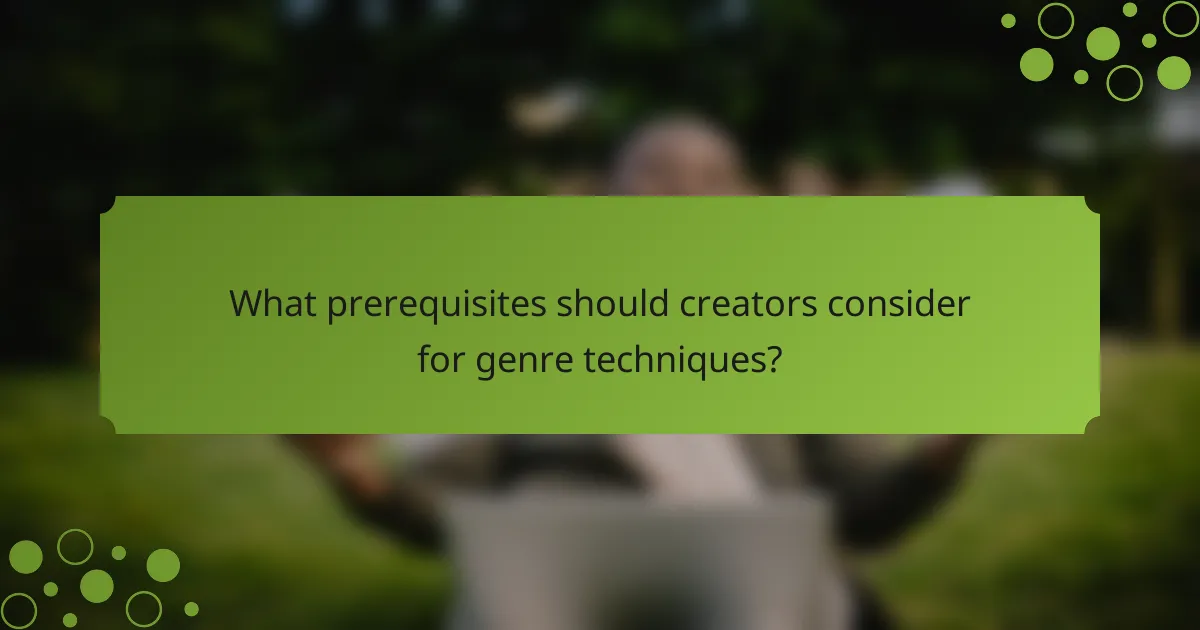Genre-specific techniques play a vital role in shaping the audience’s experience, whether through the chilling effectiveness of horror tropes, the precise timing of comedic moments, or the careful pacing of dramatic narratives. Each genre employs unique strategies to evoke specific emotions, ensuring that the storytelling resonates deeply with viewers. By understanding and utilizing these techniques, writers can craft compelling and engaging stories that captivate their audience.

What are effective horror tropes for storytelling?
Effective horror tropes are recurring themes and devices that evoke fear and suspense in storytelling. These elements resonate with audiences, creating a familiar framework that enhances the emotional impact of the narrative.
Common horror tropes
Common horror tropes include the “final girl,” where the last surviving character confronts the antagonist, and the “haunted house,” which serves as a setting filled with supernatural elements. Other popular tropes are the “jump scare,” sudden shocking moments designed to startle viewers, and “isolation,” where characters are cut off from help, amplifying their vulnerability.
These tropes can be effective because they tap into universal fears, such as death, the unknown, and loss of control. Writers often use them to build tension and create an unsettling atmosphere.
Examples of successful horror films
Films like “Halloween” and “The Texas Chainsaw Massacre” effectively utilize the final girl trope, showcasing strong female leads who confront their fears. “The Conjuring” exemplifies the haunted house trope, immersing viewers in a chilling narrative centered around a cursed location.
Another notable example is “Get Out,” which subverts traditional horror by incorporating social commentary, demonstrating how horror can reflect real-world issues while still delivering suspense and fear.
How to subvert horror tropes
Subverting horror tropes involves taking familiar elements and twisting them to surprise the audience. For instance, instead of a final girl surviving, a film might feature a male character who unexpectedly becomes the hero. This can challenge stereotypes and keep viewers engaged.
Another approach is to play with the haunted house trope by revealing that the true horror lies not in the supernatural but in the characters’ own psyche. This shift can create a more profound sense of dread and provoke deeper thought about the nature of fear.

How can comedy timing enhance narratives?
Comedy timing is crucial for enhancing narratives as it dictates the rhythm and flow of humor, making jokes land effectively. Proper timing can elevate a scene, turning a simple line into a memorable punchline that resonates with the audience.
Key principles of comedy timing
Understanding the key principles of comedy timing involves grasping the balance between setup and payoff. A well-timed pause can amplify anticipation, allowing the audience to engage more deeply with the humor. Additionally, pacing is essential; jokes should be delivered at a speed that allows for comprehension without dragging the scene.
Another principle is the use of contrast. Juxtaposing serious moments with comedic relief can enhance the impact of both, creating a dynamic narrative flow. Timing also varies across cultures; what works in one region may not resonate in another, so awareness of the audience is vital.
Famous comedic films with timing mastery
Several films exemplify masterful comedy timing, showcasing how effective pacing can enhance humor. For instance, “Airplane!” is renowned for its rapid-fire jokes and visual gags, where the timing of each punchline keeps viewers engaged and laughing. Similarly, “Monty Python and the Holy Grail” uses absurdity and timing to create memorable comedic moments that have stood the test of time.
Another notable example is “The Hangover,” which expertly balances tension and humor, allowing comedic moments to shine through amidst dramatic situations. These films illustrate that impeccable timing can transform ordinary scenes into extraordinary comedic experiences.
Techniques for improving comedic delivery
To improve comedic delivery, practice is essential. Rehearsing lines with attention to pacing and pauses can help identify the rhythm that works best for each joke. Recording performances and reviewing them can provide insights into timing and audience reactions, allowing for adjustments.
Additionally, experimenting with different delivery styles can enhance timing. For instance, varying your vocal tone or using physical comedy can add layers to the humor. Observing and analyzing performances from successful comedians can also offer valuable lessons in timing and delivery techniques.
Finally, understanding your audience is key. Tailoring your timing to fit the cultural context and expectations of your viewers can significantly improve the effectiveness of your comedic delivery.

What are the best practices for drama pacing?
Effective drama pacing involves balancing the rhythm of storytelling to maintain tension and engagement. Key practices include varying scene lengths, strategically placing climaxes, and ensuring character development aligns with plot progression.
Elements of effective drama pacing
Key elements of drama pacing include scene length, emotional beats, and the timing of plot twists. Shorter scenes can create urgency, while longer scenes allow for deeper character exploration. It’s essential to intersperse high-tension moments with quieter scenes to give the audience time to absorb the story.
Another critical aspect is the use of cliffhangers and revelations. These elements can propel the narrative forward, keeping viewers invested in the outcome. Balancing these elements ensures that the pacing feels natural and engaging.
Notable dramatic works with strong pacing
Many acclaimed films and series exemplify strong drama pacing. For instance, “Breaking Bad” masterfully builds tension through its episode structure, gradually escalating stakes while allowing for character development. Similarly, “The Shawshank Redemption” uses a mix of slow and fast-paced scenes to enhance emotional impact.
Another example is “The Godfather,” which expertly balances dialogue-heavy scenes with action, maintaining viewer interest throughout its lengthy runtime. These works demonstrate how effective pacing can elevate a narrative and keep audiences captivated.
Strategies for maintaining audience engagement
To keep audiences engaged, consider using varied pacing techniques such as alternating between action and dialogue. This contrast helps maintain interest and prevents monotony. Additionally, cliffhangers at the end of scenes or episodes can compel viewers to continue watching.
Another strategy is to ensure that each scene serves a purpose in character development or plot advancement. Avoid filler content that doesn’t contribute to the overall narrative, as this can lead to disengagement. Regularly assess pacing by seeking feedback from test audiences to identify areas for improvement.

How do genre-specific techniques differ across mediums?
Genre-specific techniques vary significantly across mediums like film, literature, and stage performance, each employing unique methods to engage audiences. Understanding these differences helps creators effectively convey themes and emotions relevant to their chosen genre.
Film vs. literature techniques
In film, visual storytelling is paramount, relying on imagery, sound, and editing to create atmosphere and tension. Horror films often use jump scares and eerie soundtracks to elicit fear, while comedies may depend on timing and visual gags. In contrast, literature utilizes descriptive language and internal monologue to build suspense or humor, allowing readers to engage their imagination.
For instance, a horror novel might delve into a character’s psychological fears through detailed narrative, while a horror film could show a character’s reaction through quick cuts and chilling music. This difference highlights the importance of medium in shaping genre-specific techniques.
Stage performance considerations
Stage performances require a unique approach due to the live audience and physical constraints. Actors must project emotions and utilize body language effectively to convey horror or comedy, as they lack the editing tools available in film. For example, a horror play may rely on suspenseful pauses and dramatic lighting to create tension, while a comedy might use exaggerated gestures and timing to enhance humor.
Moreover, the immediacy of live performance means that pacing is crucial. A slow build-up can heighten suspense in a horror play, while quick exchanges can keep the audience laughing in a comedy. Understanding these dynamics is essential for successful stage performances across genres.

What prerequisites should creators consider for genre techniques?
Creators should consider audience expectations and genre conventions when employing specific techniques. Understanding these elements helps ensure that the content resonates with viewers and meets their anticipations.
Understanding audience expectations
Knowing what the audience expects from a genre is crucial. For instance, horror fans typically anticipate suspenseful build-ups and unexpected scares, while comedy audiences look for timing and punchlines that elicit laughter. Meeting these expectations can enhance viewer satisfaction.
To gauge audience expectations, creators can analyze popular works within the genre. Engaging with fan communities and reading reviews can provide insights into what resonates and what falls flat. This understanding can guide creators in crafting their narratives effectively.
Researching genre conventions
Each genre has established conventions that creators should research and understand. For example, horror often utilizes tropes like the “final girl” or jump scares, while drama may focus on character development and emotional arcs. Familiarity with these conventions allows for more effective storytelling.
Creators can explore genre-specific resources, such as books, articles, and films, to identify common techniques and themes. A checklist of conventions can help ensure that key elements are incorporated, enhancing the overall quality of the work. Avoiding clichés while still adhering to conventions is essential for originality.

What emerging trends are shaping genre techniques?
Emerging trends in genre techniques are largely influenced by advancements in technology and changing audience preferences. As streaming platforms evolve, they introduce new storytelling methods that reshape how genres like horror, comedy, and drama are crafted and consumed.
Influence of streaming platforms
Streaming platforms have significantly altered the landscape of genre techniques by providing creators with more freedom and flexibility. Unlike traditional media, these platforms allow for varied episode lengths and formats, enabling unique storytelling approaches that cater to specific genres.
For example, horror series on streaming services often utilize cliffhangers and pacing that build tension over multiple episodes, rather than relying solely on jump scares. In contrast, comedies can experiment with shorter, punchier episodes that capitalize on rapid-fire jokes to maintain viewer engagement.
Creators should consider how the binge-watching culture affects pacing and audience expectations. It’s essential to balance narrative depth with the need for immediate gratification, ensuring that each episode delivers a satisfying experience while contributing to the overall arc.
